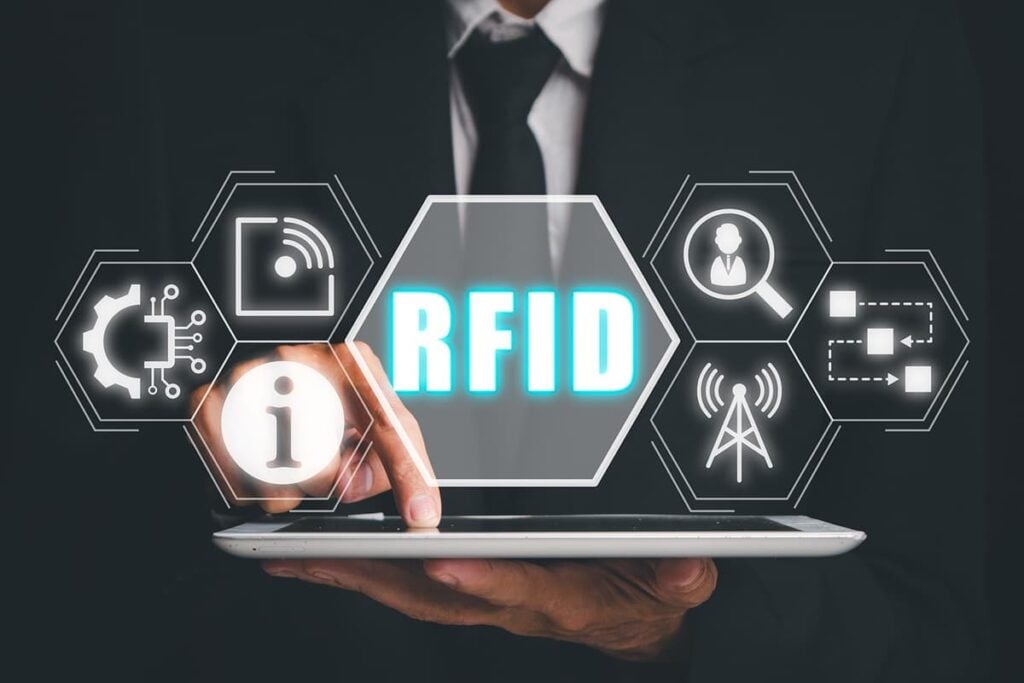Who is the World’s Leading IoT Chipmaker?
Table of contents

Investing in disruptive technologies is incredibly difficult. First, we need to collectively agree on how to define a particular technology – like the Internet of Things (IoT). What is IoT? Well, it’s when everything around us talks to the cloud and then we use machine learning algorithms to process all that data and make things more efficient. From your microwave to your car to your house, even the city you live in will have a “digital twin.” Roughly speaking.
If we can all agree that IoT is a world where everything is connected, then it would make sense to invest in the sensors, chips, and infrastructure that will be used to connect everything to the cloud. So, we need to find pure-play stocks that are building IoT hardware and software. That’s not so easy, since you then need to attribute a company’s revenues to their IoT exposure. Some analysts think that Dexcom (DXCM), a $37 billion company that sells remote glucose monitoring devices, is a leading pure-play IoT stock. Others don’t.
Even if you find pure-play stocks to invest in, that still doesn’t mean you’re going to outperform a broader market benchmark – solar and 3D printing being great examples of this. Lately, we’re seeing companies choose to dabble in more than one area of disruptive tech. Look no further than the big announcement today from NVIDIA (NVDA).
SoftBank Buys ARM
To understand this story, we need to start at the beginning. Back in June of 2017, we wrote an article titled “How to Invest in the Singularity – It’s Near.” (Simply put, “the singularity” is that moment in time when computers suddenly start improving themselves at a rate that surpasses human intelligence.) In that article, we summarized a talk given by Masayoshi Son, CEO and Founder of SoftBank, who discussed his recent $32 billion investment in ARM Holdings. Here’s an excerpt from our piece:
Mr. Son expects the population of smart robots to surpass human population in 30 years and then he goes on to talk about the explosive growth of IoT devices. He says that the chip maker he acquired last year, ARM Holdings, is expected to ship over 1 trillion IoT chips in the next 20 years with ARM IoT chips commanding an 80% market share. This will allow him to plan the future direction of IoT which will also influence the direction of AI significantly:

He remarks that during some time in the next 30 years, the two chips in each of your shoes will be more than twice as smart as you are – and you will step on them every day.
Credit: Nanalyze
SoftBank bought ARM Holdings because Mr. Son saw the growth in IoT connectivity as a critical part of investing in the future of technology. Three years later, he’s selling ARM to NVIDIA for up to $40 billion (provided the transaction gets approved), and we’ve got a few questions:
- Today, how accurate is that “80% market share” number Mr. Son threw out three years ago?
- Why is SoftBank choosing to sell what Mr. Son believed was the future of technology for mankind? Did he misjudge that, or does he just need to raise some cash?
- How does this fit into what NVIDIA does today?
There’s a chance that this merger won’t get approved, or it may come with regulatory caveats, which means we’re not going to try and answer the third question. Last time we checked in with NVIDIA was a piece we wrote this spring titled Is NVIDIA Stock Still a Good Way to Invest in AI Chips?, and if the acquisition goes through, we’ll do an update once NVIDIA offers up consolidated financials. (NVIDIA is our largest tech stock holding at the moment.)
The second question is perhaps the most difficult one to answer. SoftBank started throwing upwards of $120 billion at startups like WeWork, an investment that aged poorly. Recent banter about how SoftBank is doing some heavy options trading spooked investors, especially since the company is said to be shoring up their balance sheet on the back of some poor investments.
That leaves the first question, and the one we’re most interested in, regardless of whether this merger happens or not.
The World’s Leading IoT Chipmaker
One area of disruptive technology we haven’t directly invested in yet is IoT, for reasons we mentioned earlier. It’s tough to define IoT, and it’s tough to find pure-play stocks. It’s not just about IoT sensors and chips. Mr. Son described security and connectivity as two primary areas of focus following his purchase of ARM. (Blackberry is one company trying to reinvent itself in the area of IoT security.)
When we first heard Mr. Son speak about commanding 80% of the market for IoT chips and the grand vision he had surrounding IoT, we couldn’t help but draw some parallels to Illumina. As retail investors, we love companies with dominant market shares and – as Buffett says – moats that keep competitors at bay. So, the question remains. What percentage of the total market share for IoT chips does ARM Holdings command today?
ARM’s Market Share of IoT Chips
Once SoftBank consumed ARM Holdings, it became part of a convoluted investor deck that makes the Voynich manuscript look like a crossword puzzle for kids. If you believe in what Warren Buffett advises – invest in what you know – do not, under any circumstances, try and decipher what this 35-page abomination of an earnings deck is trying to tell you. The only information we’re given as to how the investment in ARM Holdings has matured is the $24.6 billion value they ascribe to it on their books. To understand ARM’s market share, we’re better off going back to an old dog-and-pony roadshow deck.
While it may be four years old, we unearthed an investor deck that may have been what informed Mr. Son’s presentation. When he spoke of an “80% market share in IoT chips,” he might have been talking about several discrete markets as opposed to “all IoT chips,” whatever that is.

The total addressable market (TAM) numbers seen above are totally wrong, and not just because they’re four years old. The forecasts MBAs make about future market sizes are so variable that they’re practically useless. Still, we can see – at least at that time – ARM had meaningful market share in a number of vague categorizations, mobile and embedded being the two they appear to have been dominating. The below diagram helps us understand ARM’s dominance in the smartphone market.

Four years later and we don’t know how much additional market share has been gained or lost, but we do know that there’s a lot to like about ARM’s business model.
ARM Holdings’ Business Model
ARM’s simple to understand business model means developing intellectual property (IP), licensing it to other companies, then collecting royalties as chips get sold.

One key metric the company uses is “licenses signed” which is a leading indicator for future revenues. The company’s current royalties are derived from licenses signed many years ago.

The World’s Leading Provider of IoT Chips
If defining the term IoT is tough, then good luck trying to figure out who the world’s leading provider of IoT chips is. For example, take a look at the below chart for ARM Holdings found in that old roadshow deck.

While 130 billion is a big number, the devil is in the details. Notice how it says “ARM-based,” which means these 130 billion chips are based on some technology ARM owns. Would you rather own stock in the company(s) making those 130 billion chips, or the company that makes a royalty on every chip that gets sold? Well, to answer that question we would need to look at the structure of royalty agreements, the margins for chipmakers, the industries these chips are being sold into, and the can of worms goes on. Who has time for that? Intuitively, the company collecting royalties is the better bet for risk-averse tech investors such as ourselves.
In an earlier article, we talked about Synopsys (SNPS), a company that sells software to design AI chips. Regardless of who is selling the most AI chips at any given time, Synopsis still benefits because they’re selling software that all chipmakers need to design and build new chips. They’re also the second-biggest provider of intellectual property to chipmakers. Guess who’s first?

While we don’t know what sort of things transpired inside of ARM Holdings after they were acquired by SoftBank, we do know that their IP can be found in billions of chips, IoT or otherwise. But that’s only the beginning. Mr. Son also talked about how one trillion IoT chips talking to the cloud means one trillion subscriptions, so we need to look beyond the “pick and shovel” thesis and consider the platform providers as well. ARM happens to have their own IoT platform, Pelion.

In other words, trying to identify the world’s leading provider of IoT chips isn’t the right approach to investing in IoT. Maybe Mr. Son reached this same conclusion.
Conclusion
It doesn’t make sense to focus on how the acquisition of ARM Holdings will affect NVIDIA until ink is on paper. For now, we’re more interested in understanding where ARM fits into the bigger “investing in IoT” picture. SoftBank is said to be selling off assets to shore up their balance sheet, and in times of duress, they may have to make decisions that don’t make sense looking in from the outside.
There’s everything to like about ARM Holdings’ low-risk business model of licensing and royalties. No matter who produces those trillions of IoT chips Mr. Son talked about, ARM will benefit if their intellectual property is as pervasive and durable as we’re led to believe.
Sign up to our newsletter to get more of our great research delivered straight to your inbox!
Nanalyze Weekly includes useful insights written by our team of underpaid MBAs, research on new disruptive technology stocks flying under the radar, and summaries of our recent research. Always 100% free.














